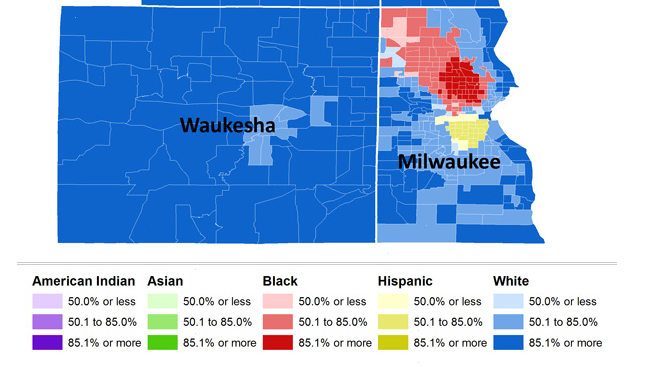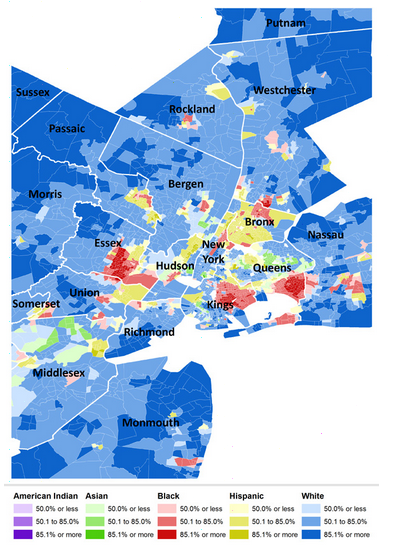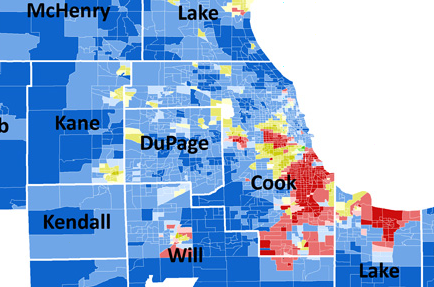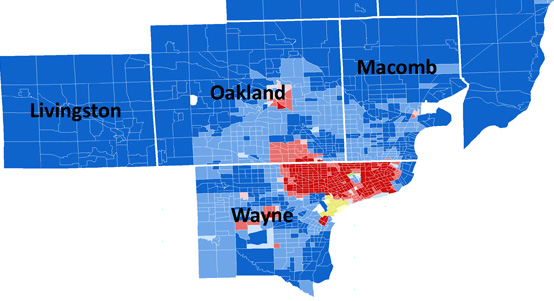Introduction
Residential segregation is an ongoing problem within the U.S. that indicates a deep societal inclination towards bias for certain ethnic and social groups within the general population of the country.
This form of community formation (i.e. Caucasians in one neighborhood, African Americans in another) extends to various social situations related to economic opportunity, education and even the way people are treated in public. Some communities and jobs simply require individuals with more money and a better educational foundation which result in a form of isolation and consolidation of different cultures in communities that are within their economic and educational strata.
It is based on this perception that opportunities related to work, education and being within a safe community are often isolated to Caucasian populations. On the other end of the spectrum, low income housing, lack of job availability and unsafe communities due to high crime rates are often seen among minority populations as seen in the case of L.A. (i.e. Los Angeles). This in effect creates social segregation wherein American society is becoming increasingly divided over racial lines (Jesdale, Morello-Frosch, and Cushing, 811-817).
Today, forms of racial segregation are also evident in society where wealth is increasingly being isolated towards the majority which in this particular case consists of the Caucasian population. The end result of such actions is that minorities remain minorities with wealth, education and connections being increasingly isolated to the upper echelons of society. It is based on this that this paper will explore the current level of racial segregation within various areas in the U.S. and attempt to explain the factors that lead to their development.
Literature Review
Origin of Residential Segregation
Residential segregation as it is known today has its origins in the current level of structural inequality within the U.S. social system. Structural inequality can be described as an inherent bias within social structures which can provide some advantages to a select group of people within society while at the same time marginalizing others (Li, Campbell, and Fernandez, 2642-2660).
This can be seen in instances related to racism, education and discrimination wherein certain segments of the population are categorized and marginalized depending on the color of their skin and their particular race (Li, Campbell, and Fernandez, 2642-2660). For example the law involving illegal immigration passed by Arizona has in effect created a form of discrimination against many Mexicans living within the U.S. who are in fact there legally.
Structural inequality is one of the main reasons behind the continued limitations in the development of community systems wherein minorities are in fact being discriminated against due to connotations involving their propensity towards illegal or criminal behavior.
One clear example where structural inequality promotes discrimination can be seen in the current employment rates within the U.S. and their correlation to race. Despite the presence of an assortment of laws barring discriminatory practices, this still occurs among several local or regional businesses (Li, Campbell, and Fernandez, 2642-2660).
While on paper it can be seen as a viable way of providing businesses with the “proper type” of employee, the fact remain that such a discriminatory hiring system has actually resulted in racial lines being drawn with white Americans normally being segregated into the upper tier of community system creation while minorities are usually set in the lower tier system.
Such a system actually perpetuates the concept of societal inequality where it has come to be believed that white Americans are more associated towards success and having better levels of education while minorities are leaning towards marginal careers at best. As explained by Friedman, Tsao, and Chen (2013), communities tend to develop along racial lines due to the availability of opportunities.
Limitation of opportunities is often the result of racial associations with illegal/criminal activity with African Americans, Mexicans and Latin Americans consisting of the three most identifiable demographics when it comes to cataloguing crime in certain parts of the U.S. An article in the New York Times examining the number of African Americans in U.S. jails shows that since 2000 there were 791,600 African inmates behind bars compared to the 603,032 that were enrolled in college.
Comparatively, during the 1980’s there were only 143,000 African Americans in jail and 463,700 enrolled in college (Friedman, Tsao, and Chen, 1477-1498). What this indicates is a growing limitation of opportunities for a minority population in the U.S. that contributes to towards residential segregation
Discrimination in Work Place Environments
Various studies conducted examining the hiring practices of various HR departments have also shown that despite the presence of affirmative action programs most HR personal tend to call people for interviews with names that sound like they belong to a majority while at times ignoring those that belong to minorities unless upper management says that they need to round out the talent pool with minorities (Li, Campbell, and Fernandez, 2642-2660).
Other instances have also shown that despite laws against discriminating individuals due to sex or race, this has not prevented HR personnel from proactively choosing men or Caucasians to fill higher positions in the company as compared to women or minorities. This is one of contributing factors that has lead to residential segregation at the present.
Methodology
The method of research that will be utilized in this paper is actually quite simple, utilizing survey data from Milwaukee, New York, Chicago and Detroit, the researcher will utilize studies that have examined the demographics of these locations and will attempt to explain why certain segments of the local population are segregated the way they are. This will include levels of segregation and census numbers.
Limitation of the Study
Due to the sheer amount of possible locations that could possibly be examined, the researcher has decided to limit the study primarily to Milwaukee, New York, Chicago and Detroit which are listed among the top 10 most segregated locations within the U.S.
Data








Data Analysis
Area Examination
As it can be seen in various inner city neighborhoods that were examined in this study, the population structure in several areas is geared towards low income families and the concentration of minorities into a single area. While on the other end of the spectrum the outer and more affluent suburbs consist predominantly of Caucasians.
Based on an examination of the research data, it can be seen that a considerable degree of “clustering” is present wherein populations of specific ethnicities are not spread out; rather, they are concentrated into small pocket communities or encompass large swaths of the given map.
It is obvious that the Caucasian population easily outstrips the population density of the other ethnicities (i.e. Asians, American Indians, African American and Hispanic) however, what is surprising is the formation of the segregated population sets wherein minority populations are increasingly concentrated within the city while white populations decrease within the city center yet increase as they approach the suburbs.
One way of analyzing this is by comparing the demographic data with the immigration and socio-economic history of the regions that are being examined.
An examination of Milwaukee, New York, Chicago and Detroit showed that on average 75.8 percent of the local population was composed of Caucasians while 18.5 percent was composed of African Americans. The remainder was a mixture of Alaskan Natives, Native Americans, Hispanics, Latinos and other races (Spivak and Monnat, 1414-1437).
What is interesting to note is that based on an examination of survey data from the year 2000 till 2010, the African American population within the areas that were being examined rose by 20% as a result of migrations of the African American population from states such as Mississippi.
The same can be said for the Hispanic and Latino population that increased also increased from 2000 to 2010 which also came about as a result of migration. The reason behind such migrations is connected to the economic robustness of the local market of the population centers that are being examined which many minorities interpreted as a “signal” so to speak to try their luck within the local area.
However, an examination of the migrating African American, Hispanic and Latin American population revealed that a disproportional amount of the immigrants were from low income families with little, if any, substantial work experience and education.
As explained by Iceland, Sharp, and Timberlake (2013), individuals with low income levels and little in the way of substantial education have a greater predilection to go for manual labor jobs due to the limited opportunities that are presented to them. As a result, they tend to concentrate within particular areas in a city center due to the availability of low income housing as well as enabling them to live closer to where they work which helps them to save money (Iceland, Sharp, and Timberlake, 97-123).
Further examination of the demographic data of Milwaukee, New York, Chicago and Detroit shows that what is present is a White majority with an increasing level of Black, Hispanic and Latino immigrants who are looking for better opportunities within the local area through work.
The concentration of Latinos, African Americans, and other minorities within the urban centers is indicative of communities created based on their educational capacity as seen in the study of Nelson (2013) which examined population concentrations and the level of education of the ethnicities there.
Nelson explains that the concentration of Caucasians in America’s suburbia is due to the fact that by virtue of their race, they have lower levels of discriminatory practices leveled against them which gives them access to more opportunities in relation to education and wealth creation.
This helps to develop the necessary income levels to actually afford a house located within the suburbs. While such a viewpoint may be controversial since few individuals would openly admit to being racist due to the negative social connotations attached to the description, the fact remains that there is still a level of racial animosity within the local population of the U.S. (Nelson, 646-657).
Evidence of this can be seen in the study of Britton and Goldsmith (2013) which examined the local population of the U.S. and saw that there was still a considerable income and education gap between the White majority population and the African American-Mexican-Latino minority population.
Neighborhoods are still drawn across “ethnic lines” so to speak with White neighborhoods often being the most economically stable and prosperous as compared to their minority counterparts (Britton and Goldsmith, 2886-2903). Other studies support such claims by showing that the areas that have been examined have had a history of racial discrimination since the mid 1990s which continues to persist due to the population imbalance (Spivak and Monnat, 1414-1437).
Access to Education as one of the reasons behind Residential Segregation
While it may be true that some minorities do have difficulties in learning due to their origins, the fact remains that such a system actually perpetuates the concept of societal inequality where it has come to be believed that white Americans are more oriented towards success while minorities are leaning towards marginal careers at best.
This is not only limited to the current school system in lower grades but also in higher education wherein the basis of college admission is the use of SAT scores as a indicator of talent in an individual (Spivak and Monnat, 1414-1437). The one problem with using SAT scores as the main criteria for evaluating college admissions is that they fail to accurately represent the true value or abilities that a person possesses.
Take for example an individual who works to support his family, gets marginally good grades in school and average SAT results, it can be assumed that the average SAT results and the marginally good grades could be attributed to the fact that this individual has to work to support his family and, as a result, could not devote the same amount of time into studying.
Most individuals would not be capable of balancing work, family obligations and going to school yet here is a person that is able to do that. Based on an examination of various applications of minorities to several colleges, it has been shown that, on average, the SAT score of white Americans outclassed that of their minority counterparts yet this is not an indicator of superior talent, rather, white students were merely given more opportunities to learn and develop as a result of their social advantage (Spivak and Monnat, 1414-1437).
This particular form of structural inequality denies the possibility of certain minorities from entering particular colleges resulting in not only a degree of inequality in lower education but in higher education as well.
The end result of this level of segregation is that minority populations are stuck with low paying jobs resulting in a greater concentration towards living within low income communities within cities. This can be seen in the study data which is indicative of the correlation between education and opportunity and how this impacts residential segregation.
Crime and Residential Segregation
Based on the information that was provided in the previous section, an individual’s status as a minority would limit their capacity to obtain a decent paying job and increases the likelihood of them turning towards a life of crime to sustain themselves. It should also be noted that a majority of the businesses within Milwaukee, New York, Chicago and Detroit are owned by the White majority with managers, shop keepers and other individuals of authority normally being White.
In their study involving discrimination and its impact on criminal behavior, Sharp, and Timberlake (2013), explain that a combination of structural inequality with tendencies of racial discrimination limits the opportunities available to minority populations which creates a greater tendency towards criminal activity.
It must be noted that the rate of crime in certain areas has been proven to go up depending on the income rate of the populations within it. As such, areas with population structures geared towards low income families and people create the possibility for criminal behaviors to occur as a result of desperation or the distinct influence from people in the surrounding environment. For example, various social scientists indicate that a person’s race is invariably connected to that person’s propensity or possibility of being able to commit a crime.
The two most identifiable minorities in connection to a vast majority of crime in the country (i.e. African American and Hispanic) are also the two most identifiable minorities in connection to poverty, social inequality and a distinct lack of education standing and achievement. It can also be seen from the study data that these minorities are also the most concentrated within city centers and are rarely seen in the suburbs.
Data from various school districts around the U.S. reveals that communities composed of African Americans and Hispanics were among those that were predicted to perform the most poorly in terms of scholastic achievement while communities composed primarily of white Americans were predicted to perform at a much higher level. This is in part due to two factors: racial prejudice against the capabilities of minorities and class prejudice against a class with a lower income threshold.
While school districts may say they are not prejudiced the fact remains that the current system of segregation within schools wherein students at the same grade level are grouped into different blocks depending on aggregate skill is in fact a form of discrimination since it encourages social class disparity. From a sociological perspective this particular form of behavior encourages the creation of criminal tendencies in people since it reinforces the social idea that minorities cannot rise above what they currently are.
This is one of the facilitators of residential segregation that this study has come across since a concentration of low income families in an area increases the predilection towards criminal behavior especially when factoring in a lack of potential opportunities.
As a result, white populations that have high levels of opportunity and income would tend to avoid living in such areas and would focus on areas with low crime rates. This is can be seen in the examination that was done wherein concentrations of white populations was in areas far away from the city.
Conclusion
What this paper has shown is that the connection between race, culture and population structures can be understood under the sociological context that since certain races and population demographics are impacted by limited opportunities, they are not given the chance to rise above their current level which causes residential segregation.
While it may be true that there are cases where minorities do in fact achieve the so called “American Dream” they represent only a small fraction of a population that is being placed in a disadvantageous situation by a system that is inadequately capable of fully providing them with the tools they need to become a success.
Works Cited
Britton, Marcus L., and Pat Rubio Goldsmith. “Keeping People In Their Place? Young – Adult Mobility And Persistence Of Residential Segregation In US Metropolitan Areas.” Urban Studies (Sage Publications, Ltd.) 50.14 (2013): 2886-2903. Print.
Friedman, Samantha, Hui-shien Tsao, and Cheng Chen. “Housing Tenure And Residential Segregation In Metropolitan America.” Demography 50.4 (2013): 1477-1498. Print.
Iceland, John, Gregory Sharp, and Jeffrey M. Timberlake. “Sun Belt Rising: Regional Population Change And The Decline In Black Residential Segregation, 1970- 2009.” Demography 50.1 (2013): 97-123. Print.
Jesdale, Bill M., Rachel Morello-Frosch, and Lara Cushing. “The Racial/Ethnic Distribution Of Heat Risk-Related Land Cover In Relation To Residential Segregation.” Environmental Health Perspectives 121.7 (2013): 811-817. Print.
Li, Huiping, Harrison Campbell, and Steven Fernandez. “Residential Segregation, Spatial Mismatch And Economic Growth Across US Metropolitan Areas.” Urban Studies (Sage Publications, Ltd.) 50.13 (2013): 2642-2660. Print.
Nelson, Kyle Anne. “Does Residential Segregation Help Or Hurt? Exploring Differences In The Relationship Between Segregation And Health Among U.S. Hispanics By Nativity And Ethnic Subgroup.” Social Science Journal 50.4 (2013): 646-657. Print.
Spivak, Andrew L., and Shannon M. Monnat. “The Influence Of Race, Class, And Metropolitan Area Characteristics On African-American Residential Segregation.” Social Science Quarterly (Wiley-Blackwell) 94.5 (2013): 1414-1437. Print.